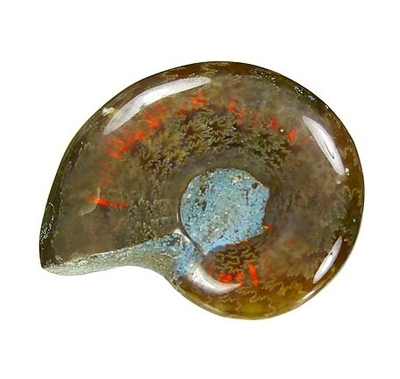Mindat locality:
3.7cm x 3cm x 1.2cm

Photo added to mindat.org
“3.7 x 3.0 x 1.2 cm
A polished specimen of the well-known Ammonite (var: Ammolite) from Madagascar. This techinically is not a mineral, but a fossil of the original Calcium Carbonate shell of the animal within. From Wikipedia "An iridescent opal-like play of color is shown in fine specimens, mostly in shades of green and red; all the spectral colors are possible, however. The iridescence is due to the microstructure of the aragonite: unlike most other gems, whose colors come from light absorption, the iridescent color of ammolite comes from interference with the light that rebounds from stacked layers of thin platelets that make up the aragonite. The thicker the layers, the more reds and greens are produced; the thinner the layers, the more blues and violets predominate. Reds and greens are the most commonly seen colors, owing to the greater fragility of the finer layers responsible for the blues. When freshly quarried, these colors are not especially dramatic; the material requires polishing and possibly other treatments in order to reveal the colors' full potential" This piece shows beautiful red flashes when rotated in the light.
”
Brian Kosnar - 17th March 2013

Photo added to mindat.org
“3.7 x 3.0 x 1.2 cm
A polished specimen of the well-known Ammonite (var: Ammolite) from Madagascar. This techinically is not a mineral, but a fossil of the original Calcium Carbonate shell of the animal within. From Wikipedia "An iridescent opal-like play of color is shown in fine specimens, mostly in shades of green and red; all the spectral colors are possible, however. The iridescence is due to the microstructure of the aragonite: unlike most other gems, whose colors come from light absorption, the iridescent color of ammolite comes from interference with the light that rebounds from stacked layers of thin platelets that make up the aragonite. The thicker the layers, the more reds and greens are produced; the thinner the layers, the more blues and violets predominate. Reds and greens are the most commonly seen colors, owing to the greater fragility of the finer layers responsible for the blues. When freshly quarried, these colors are not especially dramatic; the material requires polishing and possibly other treatments in order to reveal the colors' full potential" This piece shows beautiful red flashes when rotated in the light.
”
Brian Kosnar - 17th March 2013
No-one has added this to their favourites.
10,443,583 minIDs have been issued as of 27th Apr 2024 4:56 am UTC
